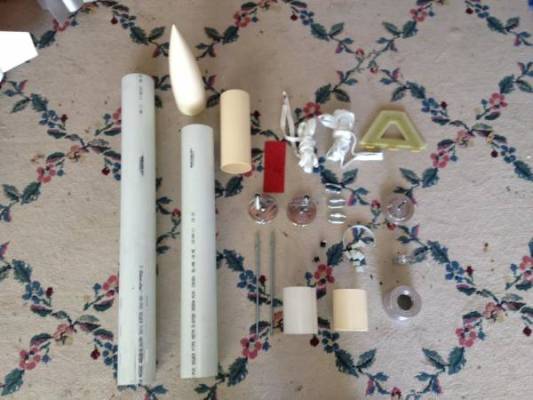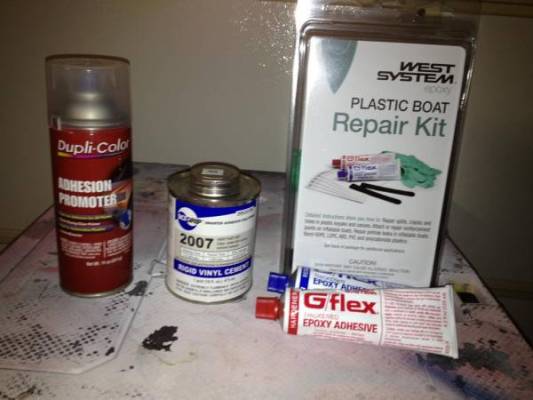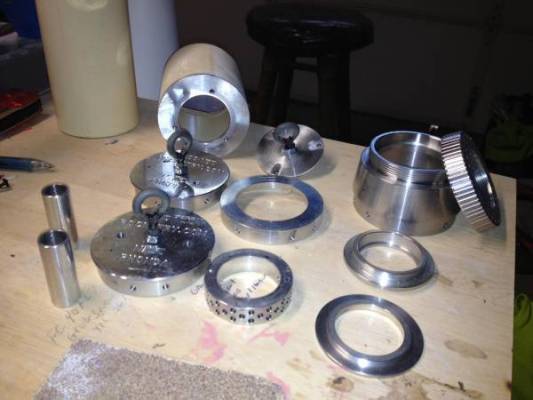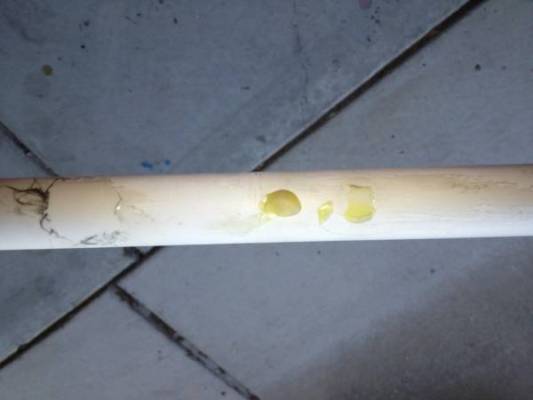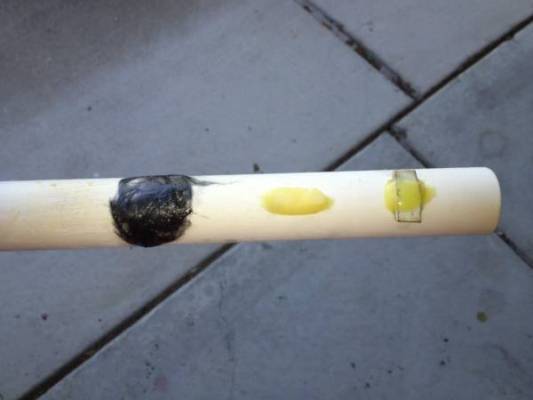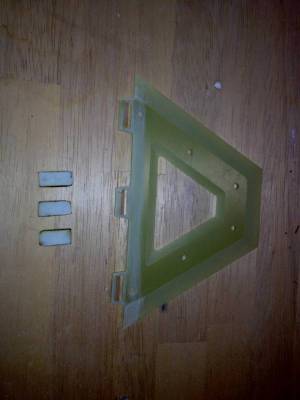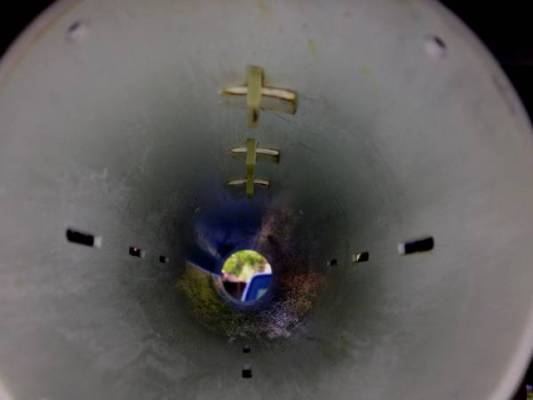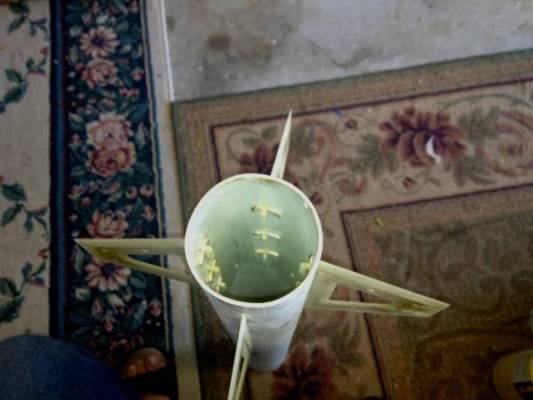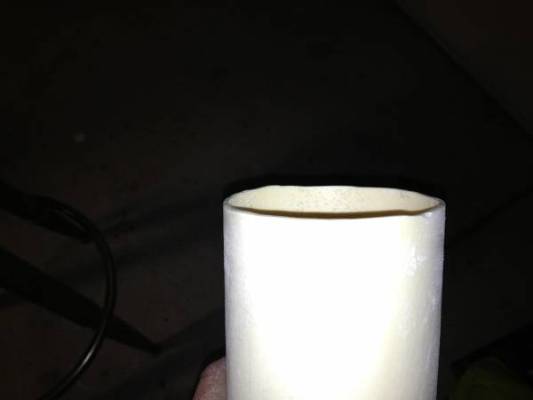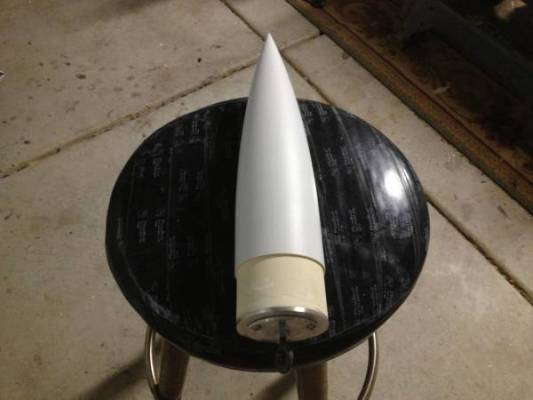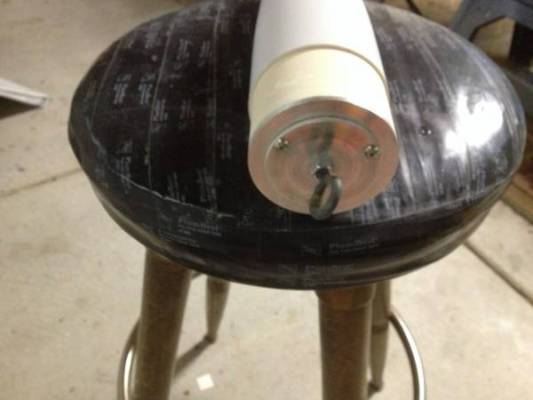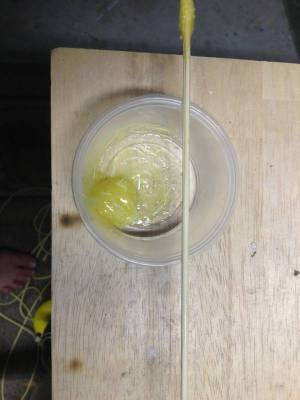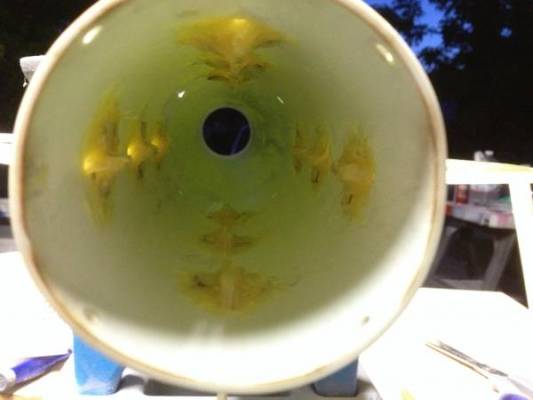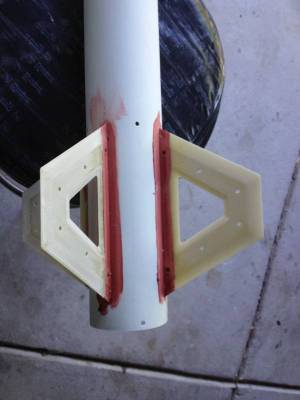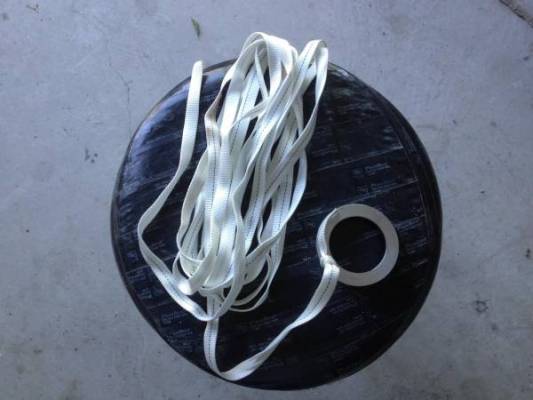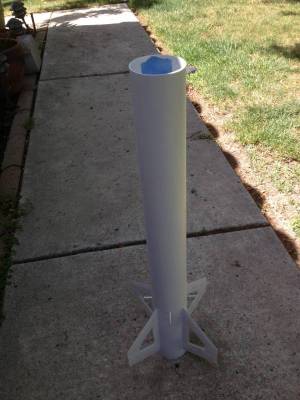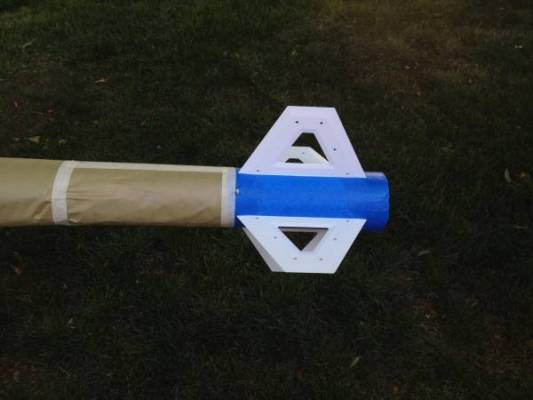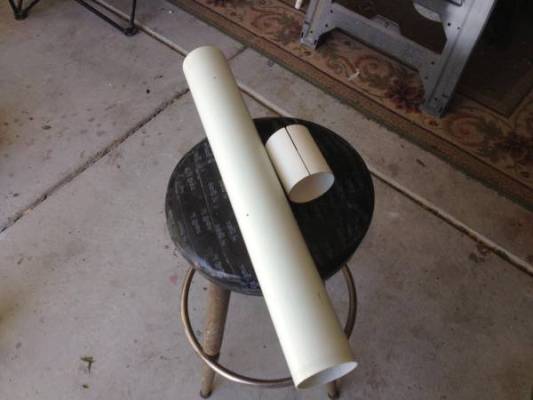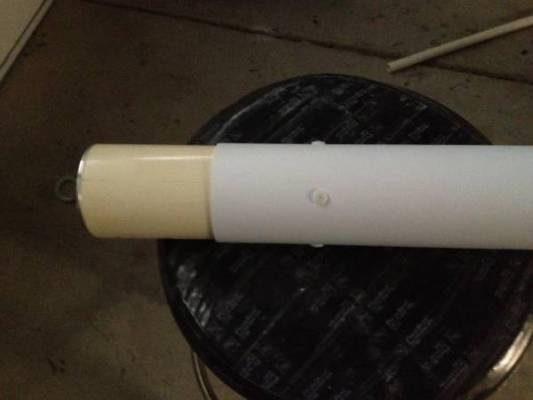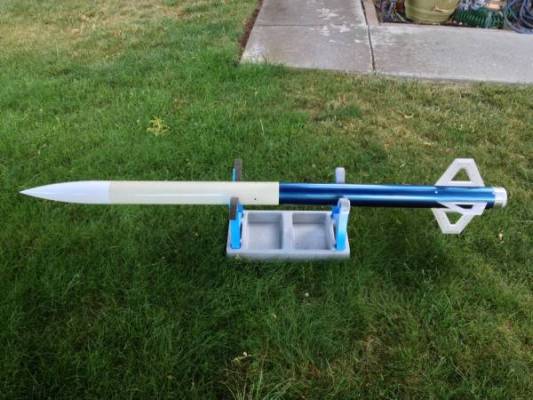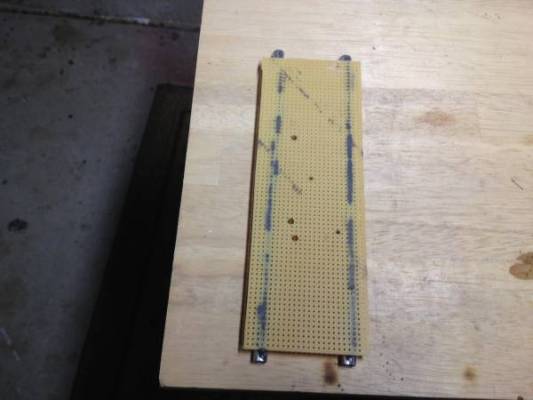Badd Azz Rocketry Mizz Rhonda
By Richard Evans
2013-05-11
| Manufacturer: | Badd Azz Rocketry  | |
| Diameter: | 3.2500 inches | |
| Length: | 72.0000 inches | |
| Style: | Sport |
A little different kit this time. It's PVC pipe, PVC nosecone, PVC av bay with fiberglass fins. Machined aluminum bulkheads and aft motor mount. The aluminum nosecone bulkhead has a removable plate for GPS transmitter. 54mm machined aluminum motor retainer with 38mm adpters.
72" length
3.25" diameter
Approx 8lbs built weight

Kit components
2013-05-11
Not pictured is the 54" purple and white parachute
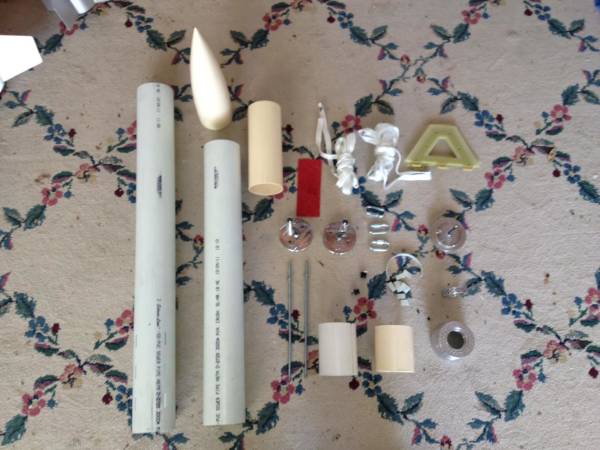
New products used on this build
2013-05-11
Since this is a PVC kit, I did a little research on which adhesives would work best. The duplicolor adhesion prometer will help the paint grab the PVC.
Thank you Ari from LUNAR for the information on using the 2007 PVC cement.

Alumimum nosecone bulkhead attachment
2013-05-11
Nosecone bulkhead epoxied in with GFlex. I sanded the coupler with 60 grit then wiped clean with alcohol. I cleaned the aluminum with a wire wheel then alcohol wiped.
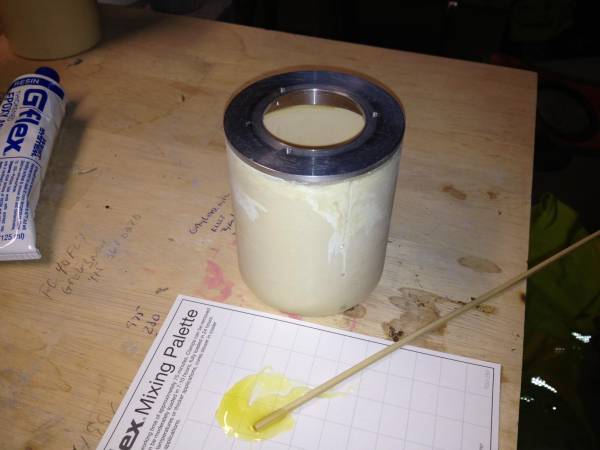
Machined aluminum parts
2013-05-11
Eric did a very nice job on the aluminum machining.
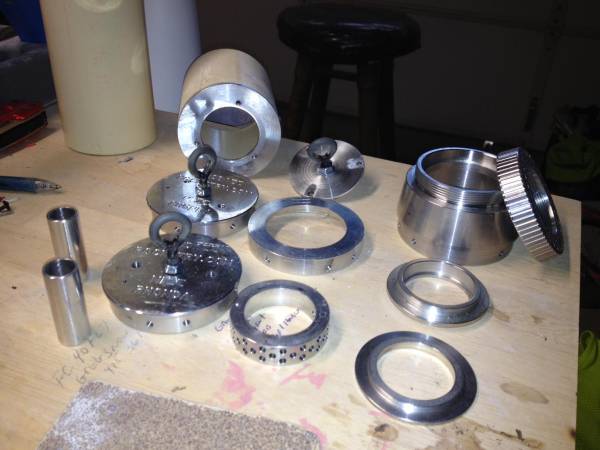
Adhesion test
2013-05-11
This test was preformed BEFORE applying adhesives to the build.
Epoxy test, only sanded with 60 grit and cleaned with alcohol. The results were not very good, poor adhesion.
The far left was a mixture of West Systems 105/205 and chopped carbon fiber, did not adhear at all.
The dot in the center was West Systems G-Flex. Good adheasion but not great.
The dot on the right was one of the PVC fin retainers iI tried to epoxy to the PVC pipe. Again, no adheasion.
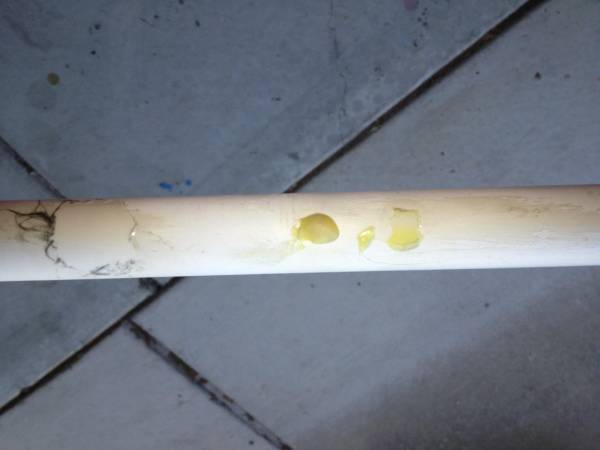
Adheasion test 2
2013-05-11
Epoxy test using 60 grit, alcohol and flame treatment. Perfect adhesion.
I would suggest Googling PVC (or plastics) flame treatment! You can melt or disform the PVC very easily!!! Be very careful doing this!!! I disformed the aft section where the motor retainer mounts slightly. It caused a bit of a challange getting the retainer in, but no major harm done.

Fin install prep.
2013-05-11
Fin and PVC fin retainers prep. The retainers were sanded with 60 grit, alcohol cleaned and then flame treated. The root of the fin was sanded with 60 grit and alcohol cleaned. Note the discoloration of the retainers, this was almost too much heat. DO NOT BURN THE PVC!
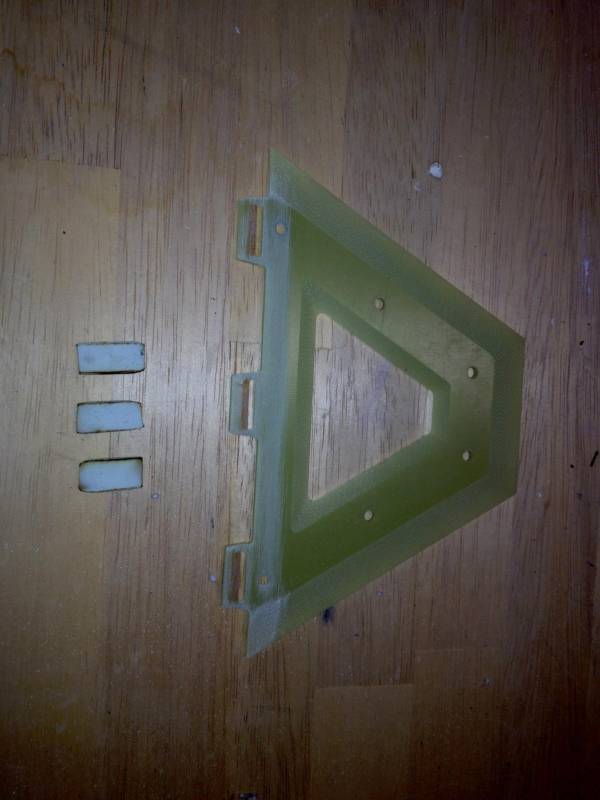
Fin Installation
2013-05-11
First fin locked into place then cemented with IPS Weld-On 2007 using syringe. The inside of the body tube was prepped with 60 grit, alcohol cleaned and then flame treated. Be careful when flame treating the body tube as it will deform (I found out about this the hard way). I used a propane torch on the INSIDE of the body tube.
I had to slightly grind the retainers to a point to get them to fit in the fin slots. Use long, long needle nose pliers.
The Weld-On 2007 is water thin, be very careful, a very small amount is needed. It melts the PVC so try not to get it on the outside surface of the body tube.
The Weld-On 2007 and syringe are available at Tap Plastics.

Fins mounted
2013-05-11
All fins locked in place with Weld-On. This only took about an hour to do all four fins. Notice the body tube slightly out of round from flame treatment.
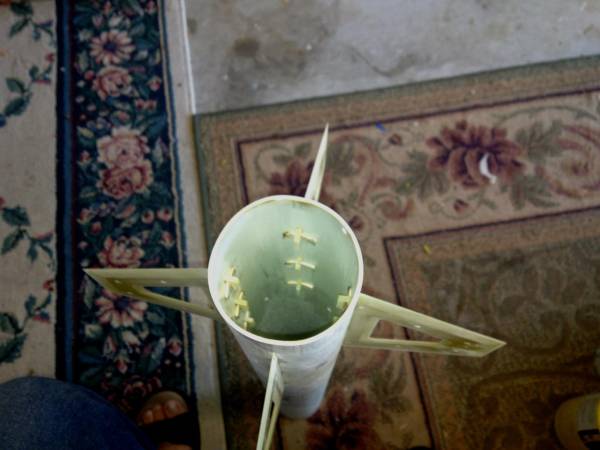
Nose cone prep
2013-05-11
The coupling end of the PVC nose cone came with a very rough cut.
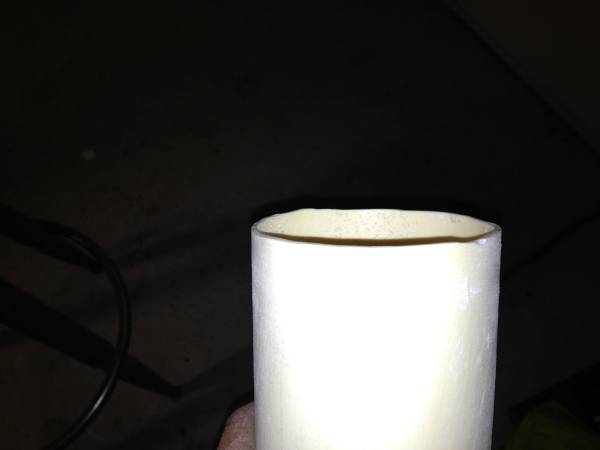
A quick pass on the sanding disk...much better.

Nose cone completed
2013-05-11
The nosecone coupling/bulkhead were prepped with 60 grit, alcohol cleaned, flame treated and West Systems G-Flex epoxy.
The nosecone sanded 150/320 grit, alcohol cleaned, primed with Duplicolor adhesion promoter primed with RustOleum primer.
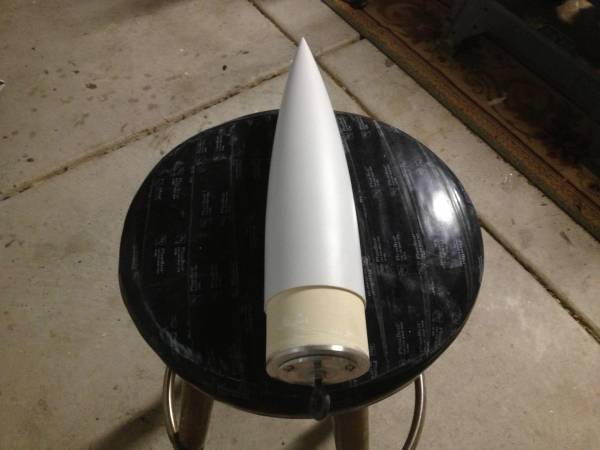
Nose cone removable bulkhead
2013-05-12
This is a nice feature for adding GPS or tracker.
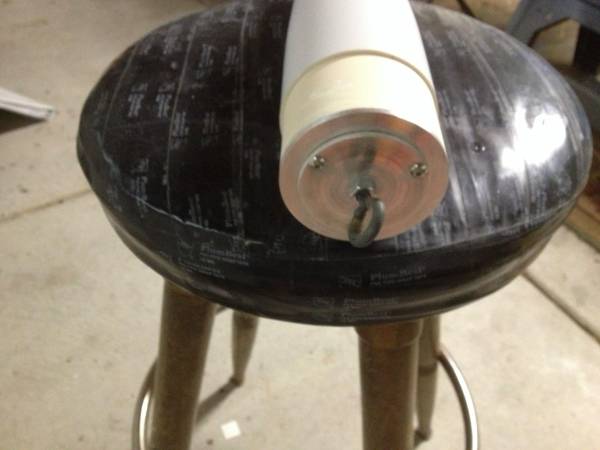
G-Flex and chopped glass
2013-05-12
I will use this mixture to secure the PVC fin locking pieces.
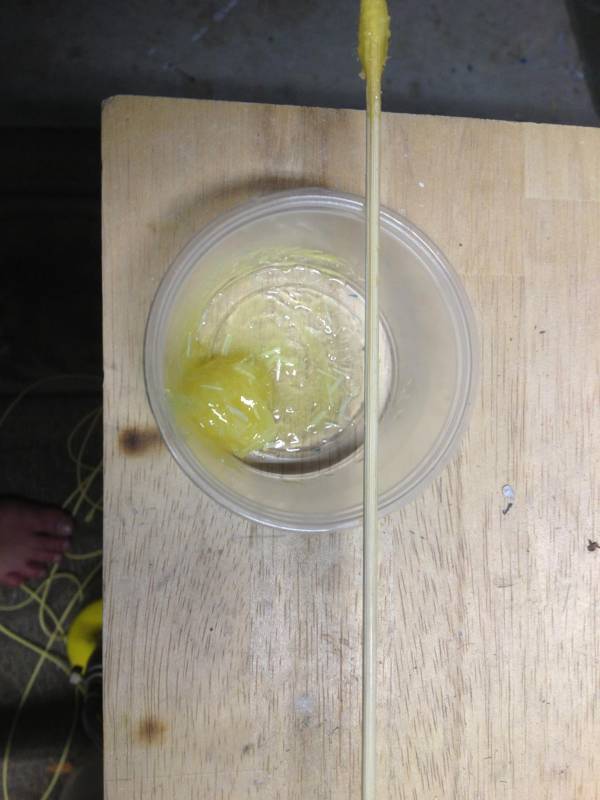
G-Flex applied to fin locks
2013-05-12
Just apply mixture over fin locks. Do one fin at a time. Allow it to set up before doing the next fin.
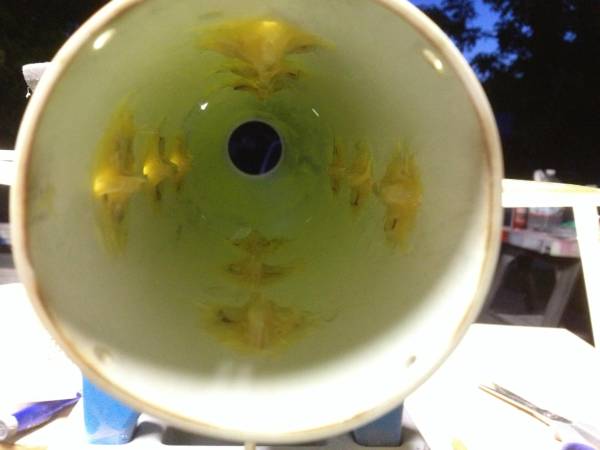
Filling the fin gaps
2013-05-12
I opted not to do external fin fillets as the fins are very secure using the above method.
The fins fit very well into the body tube, there was very littlle need for any filling. I only used spot putty to fill the small gaps. I drilled out the fin holes that got some putty in them with the correct size drill bit.
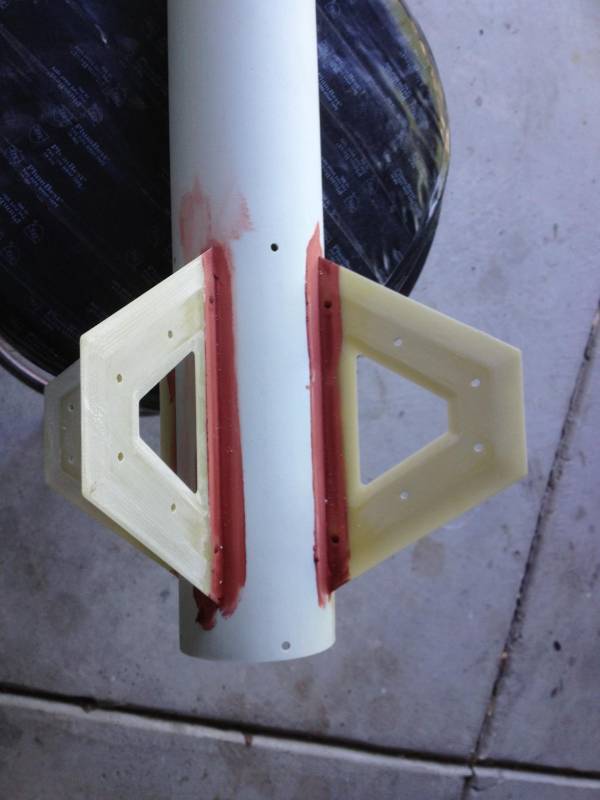
Small oops
2013-05-12
Forward centering ring has slots for the supplied shock cord (the shock cords were marked which one goes where). I used a bowline knot and used thin CA to secure the knot.
One mistake I made was not to install the forward centering ring before installing the fins. I had to install it from the forward end of the body tube. Not a big issue. Align the pre-drilled holes in the body tube with the threaded holes in the forward centering ring. Use the provided screws to temporary secure the centering ring.

Prime time
2013-05-12
Sustainer sanded with 120 grit (the PVC sands prettynicely), alcohol cleaned, DupliColor adhesion promoter, primed with RustOleum primer. Repete sanding and priming as needed. Final sanding before paint was with 400 wet/dry used with water. Clean using fresh water, allow to dry, alcohol clean then use tac cloth. Do the same with the payload section.
I removed the screws for the upper centering ring and used wooden skewer to hold in place while painting. I used rocket tape on the inside of the body tube to keep shock cord from falling out.
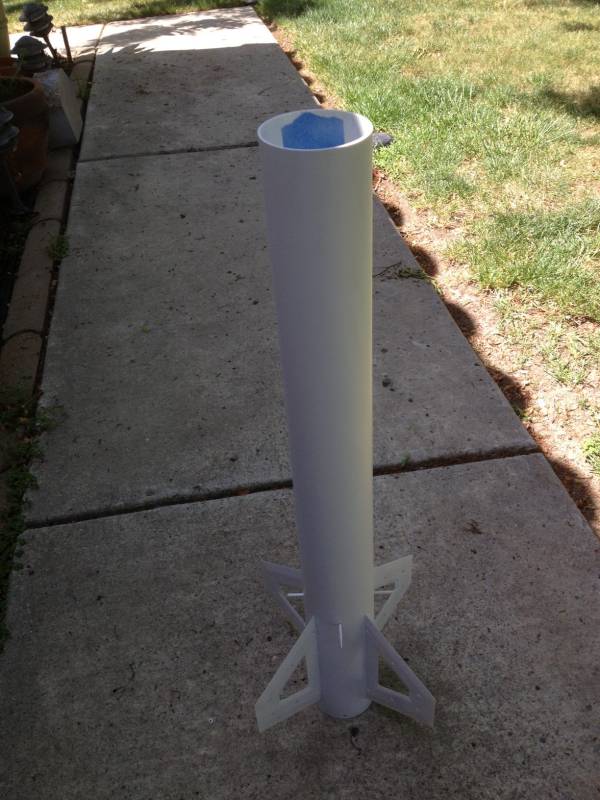
That masked rocket
2013-05-12
Maked off for fin paint which is Duplicolor Brillant Silver.
I followed the conture of the fins with tape.
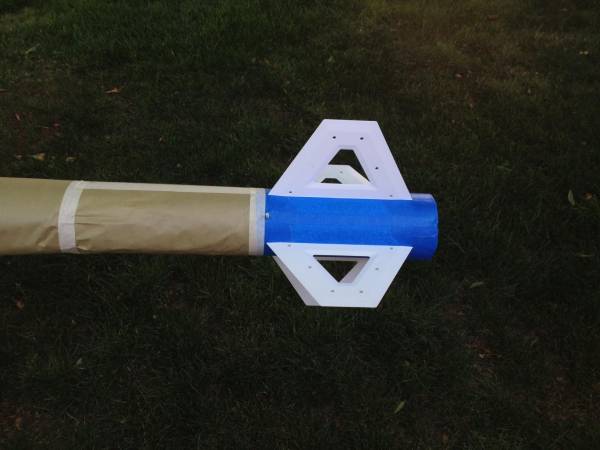
Painted out
2013-05-12
I allowed the fin paint to dry for 24 hrs then masked off. For a cleaner line on the fins, I taped starting at the bottom of fin holes near the fin root.
The body was painted with Duplicolor Deep Blue with Jet Black 5 to 1 mixture.
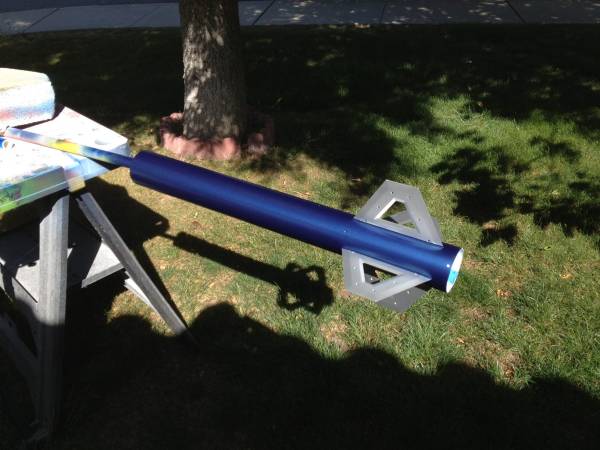
Fin Detail
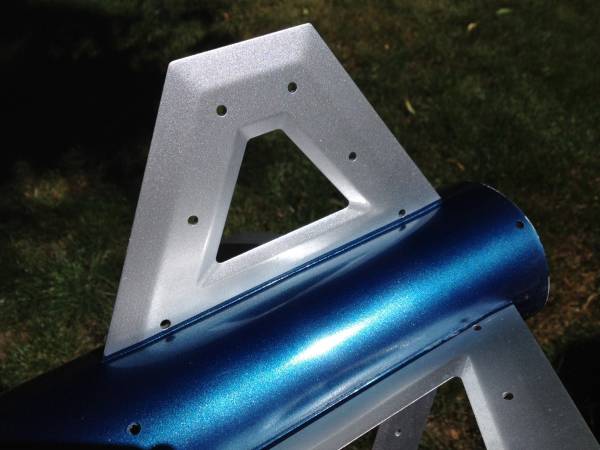
Payload section
2013-05-12
The kit comes with a split coupler. This gets epoxied in just forward of the AV bay in the payload section.
I installed the bulkheads on the AV bay, marked the center of the AV bay then slid the split coupler into the lower payload section. I slid the AV bay into the lower section of the payload bay pushing the split coupler forward to about 1/4" beyond the mark on the AV bay. Make a new mark on the AV bay. This will allow the plastic rivets to miss the forward AV bay bulkhead shoulder.
Slid the AV bay out and mark the position of the split coupler. Use a wooden dowel with 60 grit taped to it to sand the inner portion of the lower payload bay just above the mark made and about 4-5" up. Sand the split coupler with 60 grit. Alcohol clean both the coupler and the section of the payload bay that was sanded. Flame treat the coupler and CAREFULLY flame treat the payload bay where it was sanded (DO NOT OVERHEAT!!!)
Mix up a batch of West Systems G-Flex and apply to the area of the payload bay that was prepped. Slide in the coupler from the aft end, use the AV bay to push the split coupler into the NEW mark on the AV bay. Clean off any epoxy from the AV bay.

Install AV bay
2013-05-12
After the split coupler has cured, slide the AV bay back into the lower payload to drill the rivet holes in the AV bay (the holes are per-drilled in the payload bay but are too small for my 1/4" rivets). I enlarged the holes to 1/4". After each hole is drilled, install and secure a rivet.
Note the small hole drilled in the rivet head. This a 1/16" hole drilled about 3/4 of the way through the rivet head. This allows a 1mm screw to be inserted to pull the rivet out.
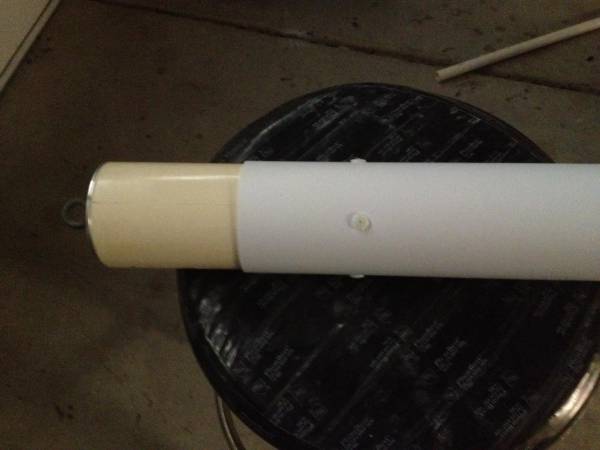
Payload and nose cone paint
2013-05-12
I used Duplicolor Champion White for the pyload sction and nose cone. I used Duplicolor Metllic Clear on the payload section, the nose cone was left just white as the metallic paint can interfer with the GPS tht will be installed in the nose cone..
The entire rocket was then clear coated with 4 coats. I allowed the paint to cure for 24 hours then wet sanded with 2000 grit, cleaned the rocket then used Meguiars rubbing compound followed by polish then wax.
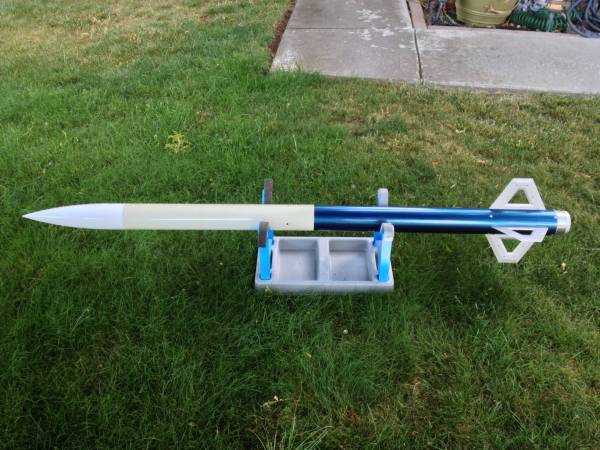
AV bay sled
2013-05-12
I used aluminum tubing to mount the perforated circuit board material (from Radio shack), JB Weld was used to secure. I cut the tubing so it would be tight against the bulkheads.
I predrilled the mounting holes for the Ravenn 3 and the Power Perch.
Note: The kit does come with a fiberglass piece to make the sled. I like this perforated stuff.

AV bay bulkheads
2013-05-12
I decided to put a terminal block on each bulkhead, I drilled a hole a bit bigger than the screw used.
The charge holders are included in the kit.
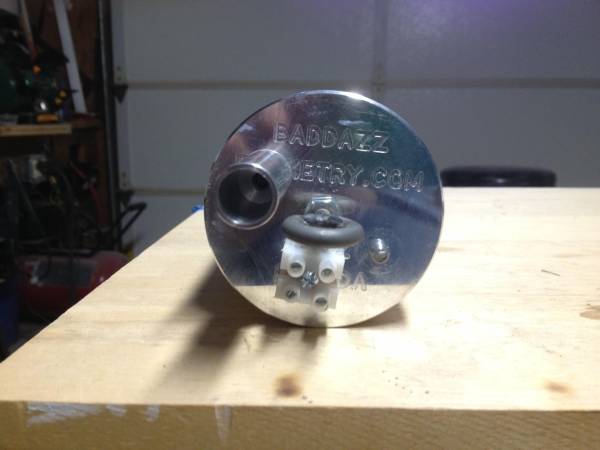
GPS mount on nose cone bulkhead
2013-05-12
Big Red Bee BeeLine 70cm GPS mounted on nosecone bulkhead.

Building review
2013-05-13

This is the finest manufactured kit I have built so far (40+ kits).
Everything fit together nicely, all the machine cut holes lined up perfectly.
There are no directions for this kit but if you follow my build there should be no issues. I did have to contact Eric on where the split coupler needed to be placed, he was very quick on his reply and more than willing to help.
I was a little leary about building a PVC kit, but after building this one I have no reason not to build another (awaiting the Defender MKII to arrive as I type this). At the time of this build, I was building the Defender MKIII another fine fiberglass kit from BAR (see my build for the MKIII).
Overall build rating 5 stars
Quality 5+ stars
Appearance 5+ stars
Completeness of kit 5 stars
Coolness 5+ stars
Flight rating.....TBD
Thank you for looking at this build.
Richard Evans
NAR 92386 L2
LUNAR 1795
Sponsored Ads
 |
 |

